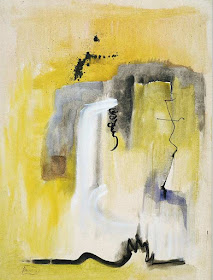Theodoros Stamos (American/Greek, 1922–1997) became known as one of the youngest of the group of Abstract Expressionists working in New York in the 1940s and 1950s. Stamos was born in New York, into a family of Greek immigrants. After studying at the American Artists School in the 1930s, his artistic style developed in the late 1940s to incorporate muted colors and organic shapes, an aesthetic he would maintain for the majority of his life. In the late 1980s, Stamos began painting his surfaces thick with paint, and his geometric shapes increasingly resembled abstract compositions. Stamos participated in the 1945 Whitney Biennial, and in 1946 the Museum of Modern Art acquired one of his paintings.(.artnet.com)
As a teenager, he won a scholarship to the American Artists School, where he studied sculpture with Simon Kennedy and Joseph Konzal. His instructor Joseph Solman, who was a member of the group The Ten, became a mentor to Stamos. At Solman's urging, Stamos visited Alfred Stieglitz's influential An American Place Gallery, where he encountered the work of Arthur Dove and Georgia O'Keeffe, among others. During this period, the late 1930s and early 1940s, Stamos held a variety of odd jobs: printer, florist, hat-blocker, and book salesman. Through one job, at a frame shop on East 18th Street, he met members of the European avant-garde, including Arshile Gorky and Fernand Léger
In 1943, when Stamos was 21 years old, prominent dealer Betty Parsons gave him a solo exhibition at her Wakefield Gallery and Bookshop. Parsons became an important ally and connection to the contemporary New York art world; Stamos would show regularly with her until 1957. By the mid-1940s, his career was becoming well established—he exhibited at the Whitney Museum annually from 1945 to 1951, at the Carnegie Institute and the Art Institute of Chicago in 1947, and at the Museum of Modern Art in 1948. Also during this period, Stamos’ work began attracting the attention of collectors. The Museum of Modern art purchased Stamos’ Sounds in the Rock in 1946. And Edward Wales Root, who became both a supporter of Stamos’ career and a benefactor of the Munson-Williams-Proctor Institute, bought the first of many paintings from the artist in 1945.
The artist’s paintings from the 1940s combine muted earth-toned colors with biomorphic imagery, suggesting geologic shapes or inchoate organic forms. This dovetails with Stamos’ interest in natural history; as artist Barnett Newman observed in the introduction to Stamos’ 1947 exhibition with Betty Parsons Gallery, “His ideographs capture the moment of totemic affinity with the rock and the mushroom, the crayfish and the seaweed. He re-defines the pastoral experience as one of participation with the inner life of the natural phenomenon.”
During the late 1940s he became a member of The Irascible Eighteen, a group of abstract painters who protested the Metropolitan Museum of Art's policy towards American painting of the 1940s and who posed for a famous picture in 1950; members of the group considered as the 'first generation' of abstract expressionists included: Willem de Kooning, Adolph Gottlieb, Ad Reinhardt, Hedda Sterne, Richard Pousette-Dart, William Baziotes, Jimmy Ernst, Jackson Pollock, James Brooks, Clyfford Still, Robert Motherwell, Bradley Walker Tomlin, Theodoros Stamos, Barnett Newman, and Mark Rothko. These artists are part of the New York School and they were referred to as The Irascibles in an article featured in an issue of Life where the infamous Nina Leen photograph was published..Wikipedia










No comments:
Post a Comment